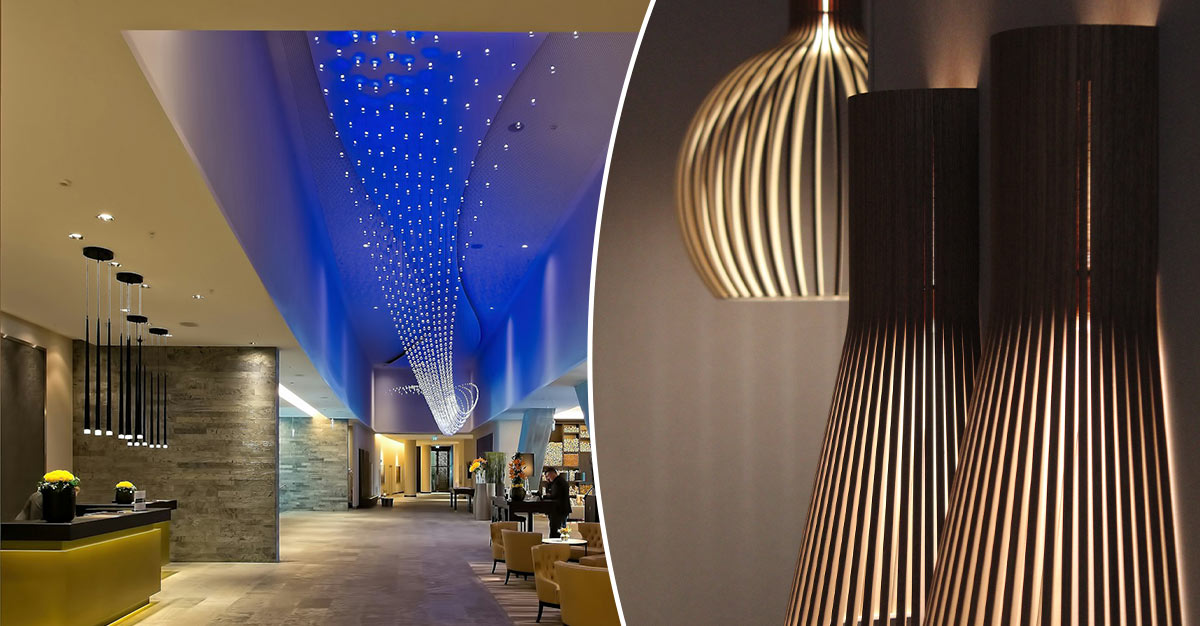What is a DALI lighting control system? To put it briefly, it is a sophisticated technology used to manage and control lighting in commercial and industrial settings. It enables precise control of light, allowing for energy efficiency, customization, and enhanced lighting quality.
What is a DALI lighting control system, basically?
DALI stands for Digital Addressable Lighting Interface lighting control system and it is a versatile solution for various environments. In this article, we will delve into the intricacies of DALI lighting control systems to provide a comprehensive understanding of their key components, functionalities, and cost considerations. So, to grasp this technology, let’s explore its key components and understand how each plays a pivotal role in the system’s operation:

DALI devices – Illuminating precision
The distinguishing feature of DALI devices is their innate ability to communicate seamlessly with each other over the DALI network. This interconnectedness fosters the capability for both individual and group control of lighting fixtures, promoting energy efficiency and enhancing flexibility in lighting design and operation. DALI-compatible devices serve as the backbone of a DALI lighting control system, encompassing a diverse range of components designed to provide precise and tailored control over lighting:
LED drivers
LED drivers are essential for regulating the power supplied to LED fixtures, allowing for meticulous control of light intensity. This capability enables dimming options, enhancing both energy efficiency and customization possibilities for lighting scenarios.
Ballasts
DALI-compatible ballasts find their primary application in fluorescent lighting systems. They offer precise control over fluorescent lamps, allowing for adjustments in light levels to ensure optimal lighting conditions that suit specific requirements.
Sensors
DALI sensors can be likened to the sensory organs of the system. They are proficient in detecting occupancy, daylight levels, and various environmental factors in real-time. This data serves as the foundation for dynamic lighting adjustments, maximizing energy savings while optimizing user comfort.
Switches
DALI switches put manual control into the hands of users, offering them the ability to interact directly with lighting fixtures. Whether the need is to turn lights on or off, or to adjust brightness levels, these switches empower occupants to tailor their lighting environment according to their preferences.
Controllers
Controllers act as the system’s central command hub, overseeing the entirety of the DALI network. They facilitate the creation of intricate lighting scenes and schedules, enabling automation and simplifying user interactions. With controllers, users can effortlessly configure and manage their lighting scenarios.
For more information please visit www.optoga.com/en/

What is a DALI lighting control system? Control gear – Bridging the gap
In the realm of DALI lighting control systems, DALI control gear plays a pivotal role as the vital intermediary connecting the network to the lighting fixtures. Its multifaceted functions are instrumental in ensuring the seamless operation of the entire system:
Signal translation
A primary responsibility of DALI control gear is the translation of digital signals generated by various DALI devices into actionable commands. These commands wield influence over several aspects of lighting, including but not limited to light intensity, color temperature adjustments, and even the precise rendering of colors for RGB fixtures. This translation process is the linchpin of the system’s ability to respond to user input and automated commands, providing the desired lighting environment.
Addressing
Within the DALI network, each individual DALI device possesses a unique address, akin to a digital fingerprint. This addressing system empowers pinpoint control and unequivocal identification of specific devices within the network. The meticulous addressing ensures that commands are directed with utmost precision, facilitating granular control over individual fixtures or groups of lights.
Feedback mechanism
Another vital function of DALI control gear is its provision of real-time feedback on the status of DALI devices. This feedback mechanism creates a closed-loop system, guaranteeing that issued commands are executed with pinpoint accuracy. It also ensures that devices within the network report their status, thereby confirming that the system operates precisely as intended. This invaluable feedback loop contributes to the reliability and effectiveness of the DALI lighting control system, assuring users of consistent and desired lighting outcomes.
The bus of the DALI lighting control system
What is a DALI lighting control system? Well, at the heart of this lighting control system lies the DALI bus, functioning as its central nervous system. This vital component serves as the conduit for communication between all DALI devices and control gear, ensuring the coordinated operation of the system.
The DALI bus offers a remarkable degree of versatility, with the capability to adapt to the specific requirements of each installation. It achieves this adaptability through two primary modes of operation: wired and wireless.
In a wired DALI bus configuration, physical wiring connections establish a robust and reliable communication network among the system’s components. This hardwired approach ensures that data transmission is secure and stable, making it suitable for installations where dependable communication is paramount.
On the other hand, a wireless DALI bus offers an entirely different dimension of flexibility. By embracing wireless communication technology, this configuration eliminates the constraints associated with physical cabling. This newfound freedom in system design proves to be advantageous in various scenarios, ranging from new construction projects where cabling can be challenging to retrofitting existing spaces where wired solutions may be impractical.
DALI controller – The command center
The DALI controller is the central command center of the system, entrusted with multifaceted responsibilities that make it an indispensable component of the system:
System management
The controller plays a pivotal role in managing the system’s overall operation. It ensures that all system components work in perfect harmony to achieve the desired lighting objectives, promoting efficient and effective system performance.
User interface
Users engage with the DALI system through the controller, which can manifest in either physical device form or as a user-friendly software-based application. This intuitive interface empowers users to effortlessly configure lighting scenes, create schedules, and fine-tune various parameters to suit their preferences.
Scene programming
The controller’s capabilities extend to scene programming, allowing users to preset and store diverse lighting scenarios tailored for different purposes. Whether it’s configuring lighting for meetings, presentations, or creating ambient lighting for relaxation, scene programming simplifies the process.
Scheduling
DALI controllers introduce the convenience of scheduling, enabling users to create automated lighting adjustments based on predefined time intervals and occupancy status. This feature not only enhances energy efficiency but also augments user comfort by ensuring that lighting aligns with the specific needs of each moment.
Integration
In select instances, DALI controllers boast seamless integration capabilities with other building management systems. This integration transcends lighting control, offering enhanced functionality and centralized control over various building systems. It embodies a holistic approach to building automation, streamlining management and promoting efficiency across the board.
The interface of DALI lighting control system
In more advanced DALI systems, a software interface enhances the capabilities of the system. This software interface provides a digital window into the DALI network, offering several valuable features:
Users have the capability to remotely monitor the status and performance of the DALI lighting control system. This feature proves especially advantageous when overseeing large-scale installations or managing multiple sites from a central location. The software interface also often encompasses data logging and analytical tools, providing valuable insights into energy consumption, occupancy patterns, and the overall health of the DALI system. Leveraging data-driven decisions can lead to further optimization and efficiency enhancements.
The software interface is equipped with diagnostic tools and alerts, enabling the swift identification and resolution of issues. This proactive approach ensures the system’s reliability and minimizes potential downtime, bolstering its operational continuity. In addition, in commercial and industrial settings where security is paramount, software interfaces can implement robust user access controls. These controls serve to restrict access solely to authorized personnel, safeguarding the system from unauthorized modifications or disruptions, thereby maintaining its integrity and functionality.
Learn more about energy and electricity: www.iea.org/energy-system/electricity

Cost considerations for a DALI lighting control system
When contemplating the deployment of a DALI lighting control system, it’s essential to understand that costs can fluctuate significantly. Several key factors come into play when evaluating the expenses associated with adopting this sophisticated technology:
System size – Scaling up
The size of your installation is a decisive factor in determining the overall cost of implementing a DALI lighting control system. Larger installations, featuring an abundance of lighting fixtures and DALI devices, naturally entail a more substantial investment. The intricacy of managing an extensive network of devices amplifies costs in terms of hardware, wiring, and programming.
Complexity – Advanced features and their price tag
The level of intricacy inherent in your chosen DALI system can exert substantial influence on costs. Systems that necessitate advanced features such as daylight harvesting, occupancy sensing, and color tuning come with augmented expenses. These features frequently demand specialized devices, sensors, and control strategies, all of which contribute to the overall cost. Nevertheless, they can also yield noteworthy energy savings and enhance user comfort over time.
DALI Devices – Quality and features
The cost of DALI-compatible devices, encompassing LED drivers and sensors, can manifest significant variation contingent upon their features and quality. High-quality devices might carry a steeper initial price tag, yet they typically yield superior long-term reliability and performance. Investing in robust and efficient DALI devices can lead to diminished maintenance costs and prolonged system longevity.
Installation – Ensuring precision
The cost associated with installation constitutes a pivotal consideration when implementing a DALI lighting control system. This encompasses diverse expenses, including wiring, labor, and commissioning. Ensuring a meticulous installation process is paramount to guarantee that the system functions precisely as intended. Engaging proficient experts well-versed in the intricacies of DALI technology may necessitate a more substantial upfront investment, yet this measure can avert complications and issues down the line.
Software and integration – Enhancing functionality
Should you opt for advanced software interfaces and seamless integration with other building systems, be prepared for supplementary costs. Licensing fees for software and the programming essential for seamless integration contribute to the overall budget. Nonetheless, the advantages of enriched functionality, centralized control, and the capability to monitor and manage the system remotely can rationalize these expenses, particularly in larger or more intricate installations.
So – What is a DALI lighting control system? It is a sophisticated solution for achieving precise control and energy savings in lighting. While the initial investment can vary, the long-term benefits of improved energy efficiency and lighting quality often justify the cost. For businesses seeking a reliable and adaptable lighting control solution, DALI is a compelling choice that combines technical excellence with environmental responsibility.



